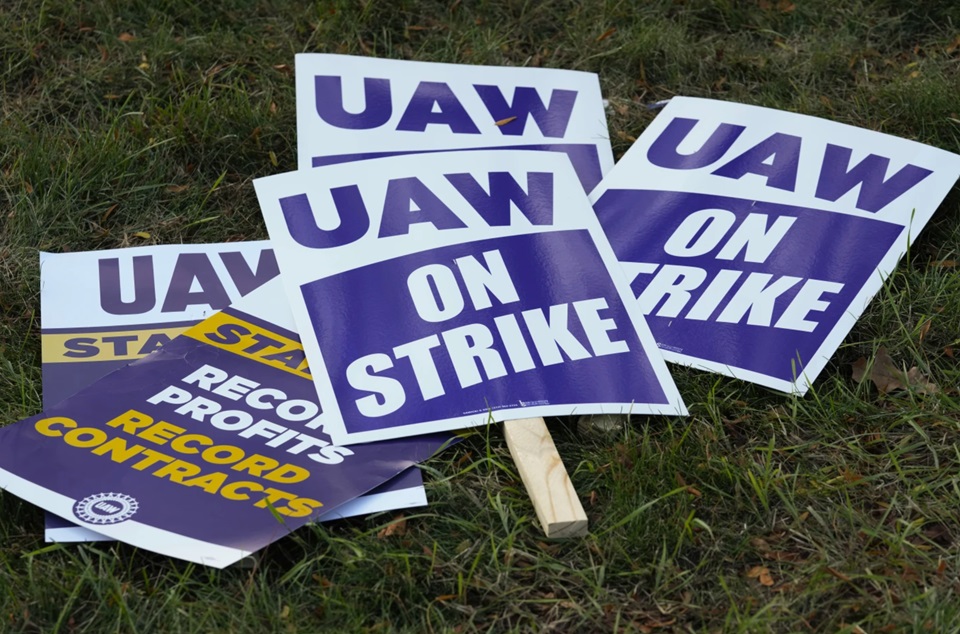
DETROIT—The new leadership and bargainers for the Auto Workers—the union’s first-ever popularly elected leaders—achieved a clean sweep of the Detroit 3 auto companies when GM became the last to settle, on October 30, following first Ford and then Stellantis.
The three tentative agreements came so fast that UAW President Shawn Fain hadn’t even taken to Twitter and Facebook as of mid-day October 30 to announce the GM deal. But President Joe Biden, the first-ever incumbent chief executive to walk a union picket line when he joined UAW strikers several weeks ago, did.
“I think it’s great,” Biden told reporters.
While details of the tentative agreement between the UAW and GM were not immediately available, it was expected to be similar to, if not identical to, the pacts with Ford and Stellantis, formerly Jeep/Chrysler.
At Ford and Stellantis, workers get a 25% wage increase over the life of those contracts, an immediate 11% signing bonus, and restoration of cost of living adjustments (COLAs). Combined, that’s over 32%, close to what the workers sought.
GM CEO Mary Parra told Wall Streeters in an earnings call that the tentative agreement “would keep us competitive” with the other two auto firms. Without it, Ford and Stellantis workers would have geared up to resume production while GM wouldn’t.
And Parra was also—with her CEO colleagues at Ford and Stellantis—a target of UAW data, showing all three earned at least $20 million each over the last three years in pay and perks while car company profits totaled $250 billion over a decade. Meanwhile, UAW members’ pay declined, both relative to inflation and, for new hires, in absolute terms.
In one respect, putting all future electric vehicle workers under the union’s master contract with each car company, GM actually had been first, with the other two tagging along.
That’s important because, when that GM agreement on EVs was announced, Fain said it “put the future of the automotive industry” in the union’s hands. The three car companies, the UAW and Biden had all agreed on converting auto plants from producing internal combustion engines and drive trains to electric-battery-powered vehicles.
The process isn’t over yet. Leaders of Ford locals met in Detroit on October 29 and unanimously voted to send the tentative agreement, which will last until April 2028, to their 57,000 members for ratification. Stellantis local leaders are flying into Detroit to review their pact which covers 43,000. GM employs 46,000 UAW members. The expiration dates will be the same for all three: Just before May Day, the international workers’ holiday.
Overall the UAW represents 150,000 workers at the Detroit 3. By the end of its “Stand Up!” first-ever strategy of keeping the car companies off balance with sudden announcements of strikes at key plants, some 50,000 had walked. Now all will return, pending ratification.
The Ford and Stellantis tentative contracts mirror each other but with some specific differences depending on the company. But at all of them, temps are to become full-timers, and there will be pension increases, too.
The three car companies dropped the COLAs, and the feds forced UAW to do so, as part of the federal loan guarantee to then-bankrupt GM and Jeep/Chrysler after the 2008 financier-caused Great Recession.
Then, Ford, though not broke, was “me too,” on eliminating the COLAs. The restored COLAs push the overall basic wage hikes to 32% or more over the life of the pacts.
The hated two-tier systems disappear over the life of all the pacts since workers will now hit the top of scale in three years, not eight.
GM settled just hours after the UAW upped the pressure on it by calling out on strike 4,000 more of its members of Local 1853 who toil at GM plants in Spring Hill, Tenn. Those plants are particularly important to GM because you can’t run a car, a truck, or an SUV without an engine, and the Spring Hill workers craft engines for GM Silverado and Sierra pickups, which are then assembled at nine other GM North American plants, including in Mexico.
Spring Hill, like the Arlington, Texas, GM plant whose UAW workers struck the week before, is a big moneymaker for the firm. Besides engines, Spring Hill workers assemble the electric Cadillac Lyriq, GMC Acadia, and Cadillac crossover SUVs.
At Stellantis some workers, especially temps (+165%) and parts workers (+76%) will get even bigger raises. So will new hires, whose starting pay, including COLAs, will increase 67%.
Stellantis also agreed not only to reopen its Belvidere, Ill., plant, bringing back 1,200 workers there but to build an additional EV manufacturing plant in Belvidere, which will employ a thousand more. Stellantis had irked UAW by shutting Belvidere just before talks began in earnest. Belvidere had also, years ago, been the first plant whose workers were split into the hated two tiers, pitting worker against worker and tanking their finances—and the city’s.
And overall, Stellantis sought to cut 5,000 workers, Fain had said. The tentative agreement will mandate that it add 5,000, instead.
>> READ MORE PEOPLE’S WORLD COVERAGE OF THE UAW STRIKE.
We hope you appreciated this article. At People’s World, we believe news and information should be free and accessible to all, but we need your help. Our journalism is free of corporate influence and paywalls because we are totally reader-supported. Only you, our readers and supporters, make this possible. If you enjoy reading People’s World and the stories we bring you, please support our work by donating or becoming a monthly sustainer today. Thank you!










